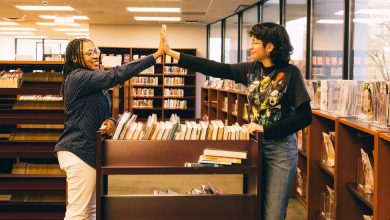Foreland, an Art Complex With Big Ambitions, Grows in Catskill

CATSKILL, N.Y. — When the artist Stef Halmos moved to New York City in 2012 with a master’s degree in fine art, she tried in vain to find a decent and affordable studio space. “The sprinklers didn’t work, there was no natural light, there was a curtain for a door — that’s what you would get,” said Halmos. “I just knew I could do it better.” It helped to have a family in the real estate business.
With the backing and mentorship of her father, the Fort Lauderdale-based developer Steve Halmos, the young artist began scouting the boroughs for a warehouse to renovate into studios for herself and her peers. The search eventually led her to the Hudson Valley, in the footsteps of so many artists who have migrated from the city looking for a better all-around deal.
Eating an ice cream cone at the edge of a creek with her wife, McKenzie Raley, an artist and doula, Halmos spied a magnificent boarded-up mill rising at the shoreline of Catskill, across the water. “I just fell in love with it,” said Halmos, who persuaded its owner, Rob Kalin, an Etsy founder who hadn’t moved forward with plans for the property, to sell to her in 2017. “I didn’t know what a mess it was.”
Halmos spent 18 months structurally stabilizing the red brick behemoth, which manufactured Union Army uniforms during the Civil War and had sat vacant since 2005, when Oren’s Furniture closed after 86 years there.
Last month, the 38-year-old artist-cum-developer completed renovations on the last of three adjacent industrial buildings totaling 85,000 square feet, creating a triangular arts complex she’s named Foreland. It will open July 1 with a series of monthlong gallery exhibitions in the village of Catskill (once home to Thomas Cole, founder of the Hudson River School of landscape painters).
The $12.5 million project was funded mostly through her family’s company, Halmos Holdings, with $1.5 million in grants from New York State for historic restoration and waterfront revitalization. It includes 31 individual private artist studios, a cooperative working space, four public galleries, a restaurant and event spaces available for rentals. Halmos worked with Emily Jockel of David Bers Architecture and Liam Turkle to design the spaces.
Halmos led a visitor through her commercial venture with the pride of a new mother (she gave birth to her first child during construction and her wife is now expecting their second). She named her project after the geological term for a cliff abutting water — the reflection she saw of the mountainous mill in the creek. “I realized I’m kind of on the cliff,” Halmos said.
She has now rented all the studios to artists including the Native American filmmaker Sky Hopinka, and the painters Laleh Khorramian and Steve Locke, with a growing waiting list. Halmos reached out directly to woo the acclaimed photographer Lyle Ashton Harris, who she knew lived nearby in Germantown.
“It was a courtship,” said Harris, who likes the aura of the past in his Foreland studio, equipped with climate control and internet but retaining an industrial rawness. “There’s diversity in the artists coming here. Stef’s cultivating a certain community, without it being forced.”
One studio is fully subsidized for a six-month annual fellowship given to an outstanding artist of color: The painter Henri Broyard was selected by a jury including Halmos, Ebony Haynes, director of the TriBeCa gallery 52 Walker and Lumi Tan, senior curator of The Kitchen. Broyard will get a solo exhibition from Aug. 5 to Sept. 25 in one of Foreland’s ground-floor public galleries.
As part of the Foreland Gallery Coalition, the art center is hosting monthlong exhibitions opening Friday with Situations, New Discretions, Document and JAG Projects. For a monthly membership fee ranging from $385 to $550, dealers can use one of Foreland’s galleries for two months a year to expand their own programs without the upfront cost of an art fair, which can run $20,000 or more.
“You show up, you put on your shows, you do your sales,” said Halmos, who provides a docent from her staff to help. Without a huge sticker price, she said, “the pressure of the sale goes down and you can do shows that perhaps are a little riskier.”
Foreland’s July exhibitions are scheduled to capitalize on the Upstate Art Weekend, from July 22-24, which is expected to draw the swelling Hudson Valley art audience to more than 145 exhibitions and open studios at regional organizations including Dia Beacon, Storm King Art Center in New Windsor, Olana in Hudson and Magazzino Italian Art in Cold Spring.
Sara Salamone, the co-founder and director of Mrs. gallery, was invited to collaborate on a group show with the dealer Rachel Uffner in a trial run of Halmos’s coalition idea last summer. It overlapped with the New Art Dealer Alliance meeting, hosted by Foreland, and the Upstate Art Weekend. “The foot traffic was incredible,” said Salamone. “This was a really economical way for us to take part in something upstate. We met a number of new clients who have continued to support our program.”
The crowds flocking to Foreland’s events over the last year have paid off as well for Main Street in Catskill, which like so many small towns had suffered severely with the advent of big-box stores but is on the upswing again. “The store owners are very happy because Foreland is generating business,” said Marietta Fagan, a longtime resident of Catskill and a barista at the recently opened coffee and vintage shop Citiot (the moniker for new people moving to the region, derived from “city idiot”). “Do you want to see a dead town,” Fagan asked, “or a town that’s flourishing?”
When Mike Ragaini started as Catskill’s building inspector in 2006, bricks were falling out of the old mill onto Main Street and he had to chase the former owners to remedy violations. “Stef’s repurposed this building into a beautiful structure,” said Ragaini, who remembers Catskill as a thriving village in the 1950s and 60s. While locals tend to complain about city people trying to tell them how to run their town, he said, “Stef’s down to earth. She kind of made herself part of the locals.”
Halmos joked that initially not everyone may have been “super jazzed about a brassy lesbian coming and buying a massive building.” But after she presented her business model at town meetings, she felt support from her neighbors. “They want to see their tax base expand,” she said. “They want to see the infrastructure of their town improved.”
Over the last five years, the median price of a single-family home in Catskill has spiked 77 percent. Ruth Adams, co-executive director of Art Omi in Ghent, has seen this trend throughout the Hudson Valley over two decades, exacerbated by people coming from the city during the pandemic. “A lot of local residents worry about the cost of housing,” she said. “Their kids can’t grow up and necessarily own a house near them.”
Adams has watched Hudson, Catskill’s sister town across the river, become a magnet for artists and collectors, with arts organizations including Basilica Hudson and Hudson Hall moving into repurposed spaces and dozens of antique shops and new stores cropping up on Main Street. “Gentrification is the story of the arts,” she said. “The question is, What do you with your space? Are you inviting community in, and is it really the community in all the layers and levels?”
Halmos has begun experimenting with outreach beyond the art world. Foreland subsidized the rent on the painter Caitlin MacBride’s studio space in exchange for the artist’s teaching a five-session self-portraiture class for people in Catskill, ages 12 up. Halmos is thinking about events that could appeal to the middle schoolers who walk past the building every day.
The ceramist Nicole Cherubini moved from Brooklyn to Hudson seven years ago and worked in isolation in a barn before settling last year into one of Foreland’s 2,000-square-foot corner studios with magnificent views of the village, mountains and water. “I was in Brooklyn so long and had missed knowing there were other artists working around me,” said Cherubini, who now runs into people at Willa’s, its ground-floor cafe, and takes advantage of Foreland’s email list for communal postings.
“Community up here is harder to find, just because we all live so far away from each other,” she said. “Foreland’s like Stef’s giant social art project.”
Foreland
From July 1, 361 Main Street and 111 Water Street, Catskill, N.Y.; forelandcatskill.com. Current exhibitions run through July 24.





